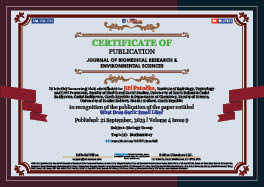Jiri Patocka*, Josef Havel and Eladia Maria Pena-Mendez
Volume4-Issue9
Dates: Received: 2023-09-13 | Accepted: 2023-09-19 | Published: 2023-09-21
Pages: 1346-1347
Abstract
Garlic (Allium sativum) is an old cultivated plant that has been used by man for millennia for its extraordinary taste and great healing power [1]. The earliest records of the use of garlic come from Egypt. The ancient Egyptians were well aware of its healing properties and ate garlic in large quantities. A Papyrus from 1600 BC depicts a strike by workers working on the construction of the pyramid, protesting that they were not given garlic. The well-known Ebers papyrus, a collection of medical prescriptions 3500 years old, mentions the use of garlic in many diagnoses such as heart weakness, headache, intestinal parasites, eczema, gynecological problems, etc. [2]. The ancient Greeks and Romans also highly valued garlic as a medicinal vegetable. They were convinced that garlic cures coughs and clears the lungs of phlegm and pus. Doctors in China and India consider garlic to be a versatile medicine, treating everything with it: from colds to "aging" [3]. Garlic was first subjected to scientific investigation by Louis Pasteur in the mid-19th century when he studied its bactericidal effects [4]. Since then, garlic has been the subject of constant interest for many researchers.
FullText HTML
FullText PDF
DOI: 10.37871/jbres1803
Certificate of Publication

Copyright
© 2023 PatoÄka J, et al. Distributed under Creative Commons CC-BY 4.0
How to cite this article
Patocka J, Havel J, Pena-Mendez EM. What Does Garlic Smell Like? J Biomed Res Environ Sci. 2023 Sep 21; 4(9): 1346-1347. doi: 10.37871/jbres1803, Article ID: JBRES1803, Available at: https://www.jelsciences.com/articles/jbres1803.pdf
Subject area(s)
References
- Londhe VP, Gavasane AT, Nipate SS, Bandawane DD, Chaudhari PD. Role of garlic (Allium sativum) in various diseases: An overview. Angiogenesis. 2011;12(13):129-134.
- Aboelsoud NH. Herbal medicine in ancient Egypt. Journal of Medicinal Plants Research. 2010;4(2):082-086.
- Malik G, Mahajan V, Dhatt AS, Singh DB, Sharma A, Mir JI, et al. Present status and future prospects of garlic (Allium sativum L.) improvement in India with special reference to long day type. J Pharmacognosy Phytochemistry. 2017;6(5):929-933.
- Khashan AA. Antibacterial activity of garlic extract (Allium sativum) against Staphylococcus aureus in vitro. Global J Bio-Sci Biotechnol. 2014;3(2):346-348.
- Majewski M. Allium sativum: facts and myths regarding human health. Rocz Panstw Zakl Hig. 2014;65(1):1-8. PMID: 24964572.
- Hussein HJ, Hameed IH, Hadi MY. A Review: Anti-microbial, Anti-inflammatory effect and Cardiovascular effects of Garlic: Allium sativum. Res J Pharm Technol. 2017;10(11):4069-4078.
- Izgi B, Gucer S, Jaćimović R. Determination of selenium in garlic (Allium sativum) and onion (Allium cepa) by electro thermal atomic absorption spectrometry. Food Chem. 2006;99(3):630-637.
- Ogra Y, Ishiwata K, Iwashita Y, Suzuki KT. Simultaneous speciation of selenium and sulfur species in selenized odorless garlic (Allium sativum L. Shiro) and shallot (Allium ascalonicum) by HPLC–inductively coupled plasma-(octopole reaction system)-mass spectrometry and electrospray ionization-tandem mass spectrometry. J Chromatography A. 2005;1093(1-2):118-125.
- Ayaz E, Alpsoy HC. Sarimsak (Allium sativum) ve geleneksel tedavide kullanimi [Garlic (Allium sativum) and traditional medicine]. Turkiye Parazitol Derg. 2007;31(2):145-9. Turkish. PMID: 17594659.
- Chygorin E, PeÄinka L, Vaňhara P, Novotný K, Krempl I, Havel J. Laser ablation synthesis of tellurium carbides using tellurium with nanodiamond nanocomposite. Rapid Commun Mass Spectrom. 2023 Jun 30;37(12):e9520. doi: 10.1002/rcm.9520. PMID: 37038657.
- Anan Y, Yoshida M, Hasegawa S, Katai R, Tokumoto M, Ouerdane L, ÅobiÅ„ski R, Ogra Y. Speciation and identification of tellurium-containing metabolites in garlic, Allium sativum. Metallomics. 2013;5(9):1215-24.